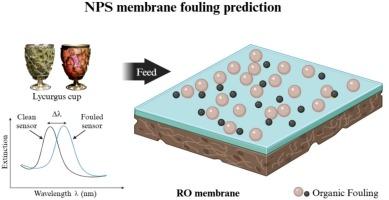纳米等离子体传感预测反渗透膜上的污染
IF 9.8
1区 工程技术
Q1 ENGINEERING, CHEMICAL
引用次数: 0
摘要
城市污水的回用对开发新的水资源,特别是农业水资源至关重要。这种方法的长期可持续性面临的挑战是饲料水中存在有机污染物。虽然使用反渗透(RO)膜进行净化可以有效地将废水脱盐以生产饮用水,但其主要缺点是由于从流出物中积累了一层有机物而导致膜污染。因此,监测预处理后的给水污染反渗透膜的倾向对反渗透操作的稳健持续至关重要。电阻抗谱(EIS)、淤泥密度指数(SDI)、浊度测量和侧流膜模块已被用于预测污染和实现定期的膜清洗。虽然EIS具有优越的RO结垢预测能力,但其他方法通常提供快速但不准确的评估,或者在时间尺度太长而无法防止结垢的情况下进行准确评估。本研究研究了一种创新的RO污染预测方法——局部表面等离子体共振(LSPR)传感。我们将LSPR与使用SDI和最近提出的带有耗散技术的石英晶体微天平的预测结果进行了比较。LSPR方法通过定量实时污染物在传感器表面的吸附,对模型和环境污染物的检测具有高灵敏度。我们的研究结果表明,LSPR在预测结垢倾向方面可以超越传统的SDI方法,这可能是因为它对距离传感器表面几十纳米的吸附材料具有很高的灵敏度。因此,LSPR提供了一种精确预测反渗透膜污染的方法,可以潜在地实现主动污染管理,提高膜的使用寿命,减少运行期间的停机时间。连续废水反渗透脱盐确保可持续水资源,通过LSPR传感进行污垢预测对于减少停机时间和优化系统效率至关重要。本文章由计算机程序翻译,如有差异,请以英文原文为准。

Nano-plasmonic sensing for predicting fouling on a reverse osmosis membrane
The reuse of municipal wastewater is crucial to the development of new water resources, especially for agriculture. A challenge to the long-term sustainability of this approach is the presence of organic foulants in the feed water. While purification using a reverse osmosis (RO) membrane can effectively desalinate wastewater effluent to produce potable water, the main drawback is fouling of the membrane by the accumulation of a layer of organic matter from the effluent. Therefore, monitoring the propensity of pre-treated feed water to foul the RO membrane is essential for robust continuous RO operation. Electrical impedance spectroscopy (EIS), silt density index (SDI), turbidity measurement, and side stream membrane modules have been employed to predict fouling and enabling scheduled membrane cleaning. While superior RO fouling prediction capabilities were shown for EIS, other methodologies commonly provide quick but inaccurate assessments or accurate assessments at timescales too long to be useful in preventing fouling. This study investigated an innovative RO fouling prediction methodology, localized surface plasmon resonance (LSPR) sensing. We compared LSPR with predictions using SDI and a recently suggested quartz crystal microbalance with dissipation technique. The LSPR method showed high-sensitivity detection to model and environmental fouling agents by quantifying real-time foulant adsorption to the sensor surface. Our findings demonstrate that LSPR can surpass the traditional SDI method in predicting fouling propensity, likely owing to its high sensitivity to adsorbed material up to tens of nanometers from the sensor surface. LSPR thus offers a precise method of predicting RO membrane fouling that can potentially enable proactive fouling management, enhancing the longevity of membranes and reducing downtime during their operation.
Synopsis
Continuous wastewater reverse osmosis desalination ensures sustainable water resources, with fouling prediction via LSPR sensing vital for minimizing downtime and optimizing system efficiency.
求助全文
通过发布文献求助,成功后即可免费获取论文全文。
去求助
来源期刊

Desalination
工程技术-工程:化工
CiteScore
14.60
自引率
20.20%
发文量
619
审稿时长
41 days
期刊介绍:
Desalination is a scholarly journal that focuses on the field of desalination materials, processes, and associated technologies. It encompasses a wide range of disciplines and aims to publish exceptional papers in this area.
The journal invites submissions that explicitly revolve around water desalting and its applications to various sources such as seawater, groundwater, and wastewater. It particularly encourages research on diverse desalination methods including thermal, membrane, sorption, and hybrid processes.
By providing a platform for innovative studies, Desalination aims to advance the understanding and development of desalination technologies, promoting sustainable solutions for water scarcity challenges.
 求助内容:
求助内容: 应助结果提醒方式:
应助结果提醒方式:


